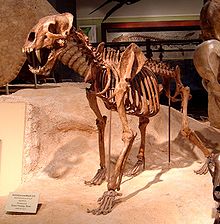Machairodontini
| Machairodontini Temporal range: Middle Miocene-Holocene, 11.6–0.01 Ma |
|
|---|---|
 |
|
| Skeleton of Homotherium serum from Texas Memorial Museum, University of Texas at Austin, Austin, Texas | |
|
Fossil
|
|
| Scientific classification | |
| Kingdom: | Animalia |
| Phylum: | Chordata |
| Class: | Mammalia |
| Order: | Carnivora |
| Family: | Felidae |
| Subfamily: | †Machairodontinae |
| Tribe: |
†Machairodontini Gill, 1872 |
| Genus | |
Machairodontini is an extinct tribe of large saber-toothed cats of the subfamily Machairodontinae, that lived in Europe, Asia, Africa, and North America, during the late middle Miocene through late living from 11.6 mya–11 000 years ago.
Machairodont means “knife-tooth” which perfectly describes the species that make up Machairodontini. These predators are related to extant cats, the Felinae, and share a common ancestor within the Felidae clade. Machairodontines are medium to large sized saber-toothed cats that would reach a size slightly larger than today's lions. This clade is also occasionally classified as being part of the Homotherini, and includes genera such as Machairodus, Hemimachairodus and Miomachairodus. They were first characterized by their scimitar canines in the upper jaw. This means that the canines are shorter and coarsely serrated, with vertical flattening. Although the upper canines are shorter than other more famous saber toothed cats such Smilodon, they are still abnormally long in comparison to the rest of the teeth in the mandible. There is also a space separating the canines and premolars known as a diastema. The bottom portion of the jaw contains small incisors that are in a straight row with a large, lower canine. These canines are not nearly as big as the upper canines. There is a diastema between the canines and the premolars in the lower jaw as well. These prehistoric predators not only have long upper canine teeth but they also have elongated limb bones, which differ from the squatter legs of the other group of saber-toothed cats, the Smilodontini. Although not many complete skeletons of machairodontine species have been found, those specimens known illustrate the long limb bones and shorter tails. The tails are of medium length and do not reach the ground as they do with cats today.
...
Wikipedia
